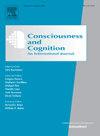Libet时钟任务的时间约束效应是否基于空间工作记忆?一个相关的和双重任务的方法
IF 2
3区 心理学
Q2 PSYCHOLOGY, EXPERIMENTAL
引用次数: 0
摘要
有意绑定研究将Libet时钟任务中时钟指针位置的移动归因于与代理相关的过程。我们研究了另一种理论,即这种结合是基于空间工作记忆过程的。在实验1的相关设计中,104名年轻的健康成年人执行Libet时钟任务,该任务的第二个版本消除了时钟的连续运动,以及空间和视觉双背任务。研究理论的唯一证据是结果绑定和空间2-back任务之间的相关性。在实验2的被试双任务设计中,94名年轻健康成人在空间记忆任务和视觉记忆任务的保持间隔内完成Libet时钟任务。空间记忆负荷对结合力的影响尚不明确。我们的研究结果表明,Libet时钟任务中的绑定并不根植于空间工作记忆过程。本文章由计算机程序翻译,如有差异,请以英文原文为准。
Is the temporal binding effect in the Libet clock-task based in spatial working memory? A correlational and a dual-task approach
Intentional binding research attributes the shift of clock hand positions in the Libet clock task to sense of agency-related processes. We investigated the alternative theory that this binding is based on spatial working memory processes. In a correlational design in Experiment 1, 104 young healthy adults performed the Libet clock task, a second version of this task eliminating the continuous movement of the clock, and a spatial and visual 2-back task. The only evidence for the investigated theory was a correlation between outcome binding and the spatial 2-back task. In an experimental within-participant dual-task design in Experiment 2, 94 young, healthy adults did the Libet clock task in the retention intervals of spatial and visual memory tasks. We could not find conclusive evidence for an effect of spatial memory load on binding. Our results suggest that binding in the Libet clock task is not rooted in spatial working memory processes.
求助全文
通过发布文献求助,成功后即可免费获取论文全文。
去求助
来源期刊

Consciousness and Cognition
PSYCHOLOGY, EXPERIMENTAL-
CiteScore
4.30
自引率
8.30%
发文量
123
期刊介绍:
Consciousness and Cognition: An International Journal provides a forum for a natural-science approach to the issues of consciousness, voluntary control, and self. The journal features empirical research (in the form of regular articles and short reports) and theoretical articles. Integrative theoretical and critical literature reviews, and tutorial reviews are also published. The journal aims to be both scientifically rigorous and open to novel contributions.
 求助内容:
求助内容: 应助结果提醒方式:
应助结果提醒方式:


